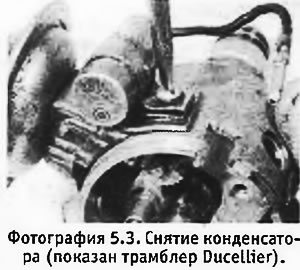2. Release the clamps of the distributor cover and remove the cover. Remove the slider from the roller.
3. Ducellier distributor. Disconnect the capacitor wire by pulling it out of the connector. Unscrew the fixing screw of the condenser and remove the condenser (see photo).

4. Paris-Rhone distributor. Disconnect the distributor low voltage wire from the terminal on the ignition coil and remove the spring clip (5) (see b/fig. 4.4). Unscrew the screw securing the locking plate of the insulating block, remove the plate and pull the insulating block out of the distributor housing. Remove the capacitor fixing screw, being careful not to drop the distributor cover clamp, and remove the capacitor together with the wires.
5. Without special equipment, the capacitor can only be checked by the method of its trial replacement. There is, however, one simple test method: manually open the breaker contacts with the ignition on. If at the same time a strong blue spark jumps between the contacts, the capacitor is faulty. A weak spark is normal.
6. Installation of the capacitor is carried out in reverse order. Tighten the fixing screw securely (screws).
